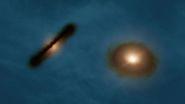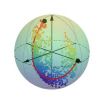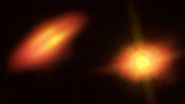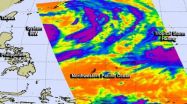(Press-News.org) BOWLING GREEN, O.—From movies to television, obesity is still considered "fair game" for jokes and ridicule. A new study from researchers at Bowling Green State University took a closer look at weight-related humor to see if anti-fat attitudes played into a person's appreciation or distaste for fat humor in the media.
"Weight-Related Humor in the Media: Appreciation, Distaste and Anti-Fat Attitudes," by psychology Ph.D. candidate Jacob Burmeister and Dr. Robert Carels, professor of psychology, is featured in the June issue of Psychology of Popular Media Culture.
Carels and Burmeister explained they designed the study to determine the nature of adults' favorable and unfavorable reactions to weight-related humor in TV and film, and to determine whether these reactions are related to preexisting negative attitudes toward obese people in general.
"Although disparaging jokes about physical disability, religion and ethnicity are often considered to be in poor taste or not politically correct, obesity stands out as a condition that is commonly made fun of in entertainment media," Burmeister said. "There has been very little research on what viewers think about this kind of humor."
Participants watched seven video clips from popular film and TV shows featuring weight-related jokes. Then they rated each clip on a number of factors, including how funny, mean, offensive, motivating and harmful they found each one. The clips represented the most common stereotypes about overweight individuals: lazy, unattractive and unintelligent. They also rated how sad, upset, angry and happy the videos made them.
Additionally, they answered questions about their attitudes and beliefs about obesity including dislike for overweight people, belief in the controllability of body weight and belief in stereotypes about obese people.
Not surprisingly, the participants' dislike for obese persons and their belief in disparaging stereotypes about obesity were associated with higher levels of appreciation for weight-related humor. Burmeister and Carels wrote that these findings are consistent with previous research that found associations between appreciation of sexist humor with sexist attitudes and beliefs.
Surprisingly, distaste for the clips did not equal a lower level of dislike for obese individuals. The researchers felt this could suggest that finding weight-related h
Unlike our solitary Sun, most stars form in binary pairs — two stars that are in orbit around each other. Binary stars are very common, but they pose a number of questions, including how and where planets form in such complex environments.
"ALMA has now given us the best view yet of a binary star system sporting protoplanetary discs — and we find that the discs are mutually misaligned!" said Eric Jensen, an astronomer at Swarthmore College in Pennsylvania, USA.
The two stars in the HK Tauri system, which is located about 450 light-years from Earth in the constellation of Taurus (The Bull), are less than five million years old and separated by about 58 billion kilometres — this is 13 times the distance of Neptune from the Sun.
The fainter star, HK Tauri B, is surrounded by an edge-on protoplanetary disc that blocks the starlight. Because the glare of the star is suppressed, astronomers can easily get a good view of the disc by observing in visible light, or at near-infrared wavelengths.
The companion star, HK Tauri A, also has a disc, but in this case it does not block out the starlight. As a result the disc cannot be seen in visible light because its faint glow is swamped by the dazzling brightness of the star. But it does shine brightly in millimetre-wavelength light, which ALMA can readily detect.
Using ALMA, the team were not only able to see the disc around HK Tauri A, but they could also measure its rotation for the first time. This clearer picture enabled the astronomers to calculate that the two discs are out of alignment with each other by at least 60 degrees. So rather than being in the same plane as the orbits of the two stars at least one of the discs must be significantly misaligned.
"This clear misalignment has given us a remarkable look at a young binary star system," said Rachel Akeson of the NASA Exoplanet Science Institute at the California Institute of Technology in the USA. "Although there have been earlier observations indicating that thistype of misaligned system existed, the new ALMA observations of HK Tauri show much more clearly what is really going on in one of these systems."
Stars and planets form out of vast clouds of dust and gas. As material in these clouds contracts under gravity, it begins to rotate until most of the dust and gas falls into a flattened protoplanetary disc swirling around a growing central protostar.
But in a binary system like HK Tauri things are much more complex. When the orbits of the stars and the protoplanetary discs are not roughly in the same plane any planets that may be forming can end up in highly eccentric and tilted orbits [1].
"Our results show that the necessary conditions exist to modify planetary orbits and that these conditions are present at the time of planet formation, apparently due to the formation process of a binary star system," noted Jensen. "We can't rule other theories out, but we can certainly rule in that a second star will do the job."
Since ALMA can see the otherwise invisible dust and gas of protoplanetary discs, it allowed for never-before-seen views of this young binary system. "Because we're seeing this in the early stages of formation with the protoplanetary discs still in place, we can see better how things are oriented," explained Akeson.
Looking forward, the researchers want to determine if this type of system is typical or not. They note that this is a remarkable individual case, but additional surveys are needed to determine if this sort of arrangement is common throughout our home galaxy, the Milky Way.
Jensen concludes: "Although understanding this mechanism is a big step forward, it can't explain all of the weird orbits of extrasolar planets — there just aren't enough binary companions for this to bethe whole answer. So that's an interesting puzzle still to solve, too!"
INFORMATION:
Notes
[1] If the two stars and their discs are not all in the same plane, the gravitational pull of one star will perturb the other disc, making it wobble or precess, and vice versa. A planet forming in one of these discs will also be perturbed by the other star, which will tilt and deform its orbit.
More information
The Atacama Large Millimeter/submillimeter Array (ALMA), an international astronomy facility, is a partnership of Europe, North America and East Asia in cooperation with the Republic of Chile. ALMA is funded in Europe by the European Southern Observatory (ESO), in North America by the U.S. National Science Foundation (NSF) in cooperation with the National Research Council of Canada (NRC) and the National Science Council of Taiwan (NSC) and in East Asia by the National Institutes of Natural Sciences (NINS) of Japan in cooperation with the Academia Sinica (AS) in Taiwan. ALMA construction and operations are led on behalf of Europe by ESO, on behalf of North America by the National Radio Astronomy Observatory (NRAO), which is managed by Associated Universities, Inc. (AUI) and on behalf of East Asia by the National Astronomical Observatory of Japan (NAOJ). The Joint ALMA Observatory (JAO) provides the unified leadership and management of the construction, commissioning and operation of ALMA.
This research was presented in a paper entitled "Misaligned Protoplanetary Disks in a Young Binary Star System", by Eric Jensenand Rachel Akeson, to appear in the 31 July 2014 issue of the journal Nature.
The team is composed of Eric L. N. Jensen (Dept. of Physics & Astronomy, Swarthmore College, USA) and Rachel Akeson (NASA Exoplanet Science Institute, IPAC/Caltech, Pasadena, USA).
ESO is the foremost intergovernmental astronomy organisation in Europe and the world's most productive ground-based astronomical observatory by far. It is supported by 15 countries: Austria, Belgium, Brazil, the Czech Republic, Denmark, France, Finland, Germany, Italy, the Netherlands, Portugal, Spain, Sweden, Switzerland and the United Kingdom. ESO carries out an ambitious programme focused on the design, construction and operation of powerful ground-based observing facilities enabling astronomers to make important scientific discoveries. ESO also plays a leading role in promoting and organising cooperation in astronomical research. ESO operates three unique world-class observing sites in Chile: La Silla, Paranal and Chajnantor. At Paranal, ESO operates the Very Large Telescope, the world's most advanced visible-light astronomical observatory and two survey telescopes. VISTA works in the infrared and is the world's largest survey telescope and the VLT Survey Telescope is the largest telescope designed to exclusively survey the skies in visible light. ESO is the European partner of a revolutionary astronomical telescope ALMA, the largest astronomical project in existence. ESO is currently planning the 39-metre European Extremely Large optical/near-infrared Telescope, the E-ELT, which will become "the world's biggest eye on the sky".
Links
* Research paper: http://www.eso.org/public/archives/releases/sciencepapers/eso1423/eso1423a.pdf
* NRAO press release about HK Tauri results: https://public.nrao.edu/news/pressreleases/young-binary-star-system-form-planets-with-weird-orbits
* More about ALMA: http://www.eso.org/public/teles-instr/alma/
* Photos of ALMA: http://www.eso.org/public/images/archive/category/alma/
* Videos of ALMA: http://www.eso.org/public/videos/archive/category/alma/
* ALMA brochure: http://www.eso.org/public/products/brochures/alma_brochure_en/
* The movie ALMA — In Search of our Cosmic Origins: http://www.eso.org/public/videos/eso1312a/
* The ALMA Photo Book In Search of our Cosmic Origins – The Construction of the Atacama Large Millimeter/submillimeter Array: http://www.eso.org/public/products/books/alma-photobook/
* More press releases with ALMA: http://www.eso.org/public/news/archive/search/?adv=&facility=36
Contacts
Eric L. N. Jensen
Lead Scientist, Swarthmore College
Philadelphia, USA
Tel: +1 610-328-8249
Email: ejensen1@swarthmore.edu
Rachel Akeson
NASA Exoplanet Science Institute, IPAC/Caltech
Pasadena, USA
Tel: +1 626-395-1812
Email: rla@ipac.caltech.edu
Charles E. Blue
Public Information Officer, National Radio Astronomy Observatory
Charlottesville, USA
Tel: + 1 434 296 0314
Cell: +1 202 236 6324
Email: cblue@nrao.edu
Richard Hook
Public Information Officer, ESO
Garching bei München, Germany
Tel: +49 89 3200 6655
Cell: +49 151 1537 3591
Email: rhook@eso.org
umor to be mean or offensive has little to do with how much people like or dislike obese persons generally.
The researchers felt the lack of an association between the dislike of obese people and distaste for the videos could have more to do with how strongly the respondents believe in negative stereotypes of obese individuals. The more strongly people believed that obesity was a controllable condition, the less aversion they had for the humor.
In the study, Burmeister and Carels wrote that by being able to blame targets of humor for their obesity, viewers are able to feel less upset by potentially offensive jokes.
"Some theories of humor suggest that we laugh at unfortunate events more when they happen to people we don't like," said Burmeister. "People with obesity are often stigmatized and blamed for their weight, which might be related to why viewers feel comfortable laughing at jokes about a character's weight, even if the jokes are a bit mean-spirited."
The study also found that an individual's Body Mass Index was associated with his or her appreciation of weight-related humor. This suggests that humor directed at an obese target's weight might remind viewers of their own weight and the negative feelings that may be associated.
Those who disliked the weight-related humor were less likely to believe in disparaging stereotypes about obesity, consistent with the opposite association between humor appreciation and belief in disparaging stereotypes.
INFORMATION: END
ALMA finds double star with weird and wild planet-forming discs
2014-07-30
ELSE PRESS RELEASES FROM THIS DATE:
Innovative scientists update old-school pipetting with new-age technology
2014-07-30
CAMBRIDGE, Mass. (July 30, 2014) A team of Whitehead Institute researchers is bringing new levels of efficiency and accuracy to one of the most essential albeit tedious tasks of bench science: pipetting. And, in an effort to aid the scientific community at large, the group has established an open source system that enables anyone to benefit from this development free of charge.
Dubbed "iPipet," the system converts an iPad or any tablet computer into a "smart bench" that guides the execution of complex pipetting protocols. iPipet users can also share their pipetting designs ...
Mapping the optimal route between 2 quantum states
2014-07-30
As a quantum state collapses from a quantum superposition to a classical state or a different superposition, it will follow a path known as a quantum trajectory. For each start and end state there is an optimal or "most likely" path, but it is not as easy to predict the path or track it experimentally as a straight-line between two points would be in our everyday, classical world.
In a new paper featured this week on the cover of Nature, scientists from the University of Rochester, University of California at Berkeley and Washington University in St. Louis have shown ...
Young binary star system may form planets with weird and wild orbits
2014-07-30
Unlike our solitary Sun, most stars form in binary pairs -- two stars that orbit a common center of mass. Though remarkably plentiful, binaries pose a number of questions, including how and where planets form in such complex environments.
While surveying a series of binary stars with the Atacama Large Millimeter/submillimeter Array (ALMA), astronomers uncovered a striking pair of wildly misaligned planet-forming disks in the young binary star system HK Tau. These results provide the clearest picture ever of protoplanetary disks around a double star and could reveal important ...
Scientists reproduce evolutionary changes by manipulating embryonic development of mice
2014-07-30
A group of researchers from the University of Helsinki and the Universitat Autònoma de Barcelona have been able experimentally to reproduce in mice morphological changes which have taken millions of years to occur. Through small and gradual modifications in the embryonic development of mice teeth, induced in the laboratory, scientists have obtained teeth which morphologically are very similar to those observed in the fossil registry of rodent species which separated from mice millions of years ago.
To modify the development of their teeth, the team from the Institute ...
Conservation scientists asking wrong questions on climate change impacts on wildlife
2014-07-30
Scientists studying the potential effects of climate change on the world's animal and plant species are focusing on the wrong factors, according to a new paper by a research team from the Wildlife Conservation Society, University of Queensland, and other organizations. The authors claim that most of the conservation science is missing the point when it comes to climate change.
While the majority of climate change scientists focus on the "direct" threats of changing temperatures and precipitation after 2031, far fewer researchers are studying how short-term human adaptation ...
Antarctic ice sheet is result of CO2 decrease, not continental breakup
2014-07-30
DURHAM, N.H. – Climate modelers from the University of New Hampshire have shown that the most likely explanation for the initiation of Antarctic glaciation during a major climate shift 34 million years ago was decreased carbon dioxide (CO2) levels. The finding counters a 40-year-old theory suggesting massive rearrangements of Earth's continents caused global cooling and the abrupt formation of the Antarctic ice sheet. It will provide scientists insight into the climate change implications of current rising global CO2 levels.
In a paper published today in Nature, Matthew ...
NASA catches two tropical troublemakers in Northwestern Pacific: Halong and 96W
2014-07-30
There are two tropical low pressure areas in the Northwestern Pacific Ocean today and they're close enough to each other to be captured in one image generated from data gathered by NASA's Aqua satellite.
NASA's Aqua satellite flew over both Tropical Storm Halong and developing System 96W early on July 30 and the Atmospheric Infrared Sounder (AIRS) instrument captured infrared data on them in one image. Both systems show powerful thunderstorms stretching high into the troposphere with cloud top temperatures as cold as -63F/-52C. Those thunderstorms have the potential for ...
Watching Schrödinger's cat die (or come to life)
2014-07-30
One of the famous examples of the weirdness of quantum mechanics is the paradox of Schrödinger's cat.
If you put a cat inside an opaque box and make his life dependent on a random event, when does the cat die? When the random event occurs, or when you open the box?
Though common sense suggests the former, quantum mechanics – or at least the most common "Copenhagen" interpretation enunciated by Danish physicist Neils Bohr in the 1920s – says it's the latter. Someone has to observe the result before it becomes final. Until then, paradoxically, the cat is both dead and ...
Fear of losing money, not spending habits, affects investor risk tolerance, MU study finds
2014-07-30
As the U.S. economy slowly recovers, many investors remain wary about investing in the stock market. Investors' "risk tolerance," or their willingness to take risks, is an important factor for investors deciding whether, and how much, to invest in the stock market. Now, Michael Guillemette, an assistant professor of personal financial planning in the University of Missouri College of Human Environmental Sciences, along with David Nanigian, an associate professor at the American College, analyzed the causes of risk tolerance and found that loss aversion, or the fear of losing ...
When cooperation counts
2014-07-30
Everybody knows the shortest distance between two points is a straight line, and now Harvard researchers have evidence that sperm have been taking the familiar axiom to heart.
Though competition among individual sperm is usually thought to be intense, with each racing for the chance to fertilize the egg, Harvard scientists say in some species, sperm form cooperative groups that allow them to take a straighter path to potential fertilization.
A new study, conducted by Heidi Fisher, a post-doctoral student working in the lab of Hopi Hoekstra, Howard Hughes Investigator ...





